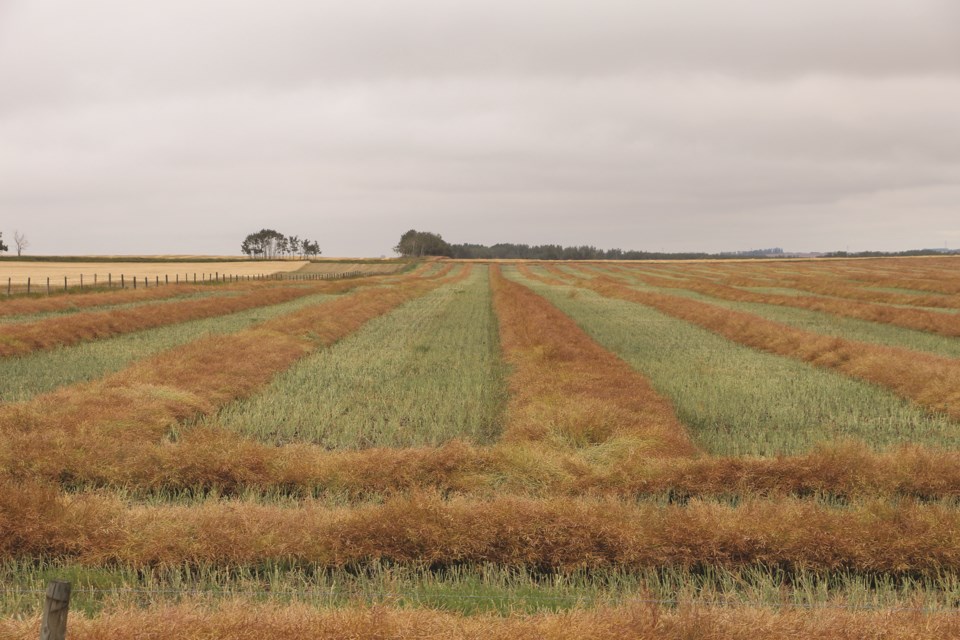A year after Rocky View County (RVC) declared a state of agricultural disaster as a result of prolonged drought conditions, the County’s agricultural services officials are pleased to say crop conditions in 2022 have been much more promising.
Laura Poile, RVC’s agricultural services officer, said the region’s most commonly grown crops – wheat, barley, canola, and peas – have seen improved growing potential this year compared to 2021.
“Crops struggled earlier in the year, due to drier conditions which led to uneven germination,” she said in a statement to the Rocky View Weekly. “Wheat has been the exception, [it’s] looking good throughout.”
The positive sentiment is reflected in Alberta’s 2022 Crop Report. Last updated on July 29, the document highlights above average expectations for both provincial crop growing conditions and yields.
According to the report, on average, Alberta’s major crops are rated as 74 per cent good to excellent this year, compared to a 10-year average of 66 per cent. Yield expectations, meanwhile, are 110 per cent of the 10-year provincial average.
“All regions of the province are reporting yield estimates relatively consistent with or ahead of long term normal,” the report states.
“At this time last year, only 20 per cent of all crops were rated as good or excellent and yield expectations were only 60 per cent of the 10-year average.”
Poile added the biggest threat to RVC producers lately has been hail, which has already inflicted heavy damage on crops in certain areas of the region.
“In areas that haven’t been affected by hail, the crops are decent this year,” she said.
The mostly-positive growing conditions are in stark contrast to this time last year, when the County declared a state of agricultural disaster during a prolonged heat wave that plagued western Canada in July and August 2021.
Low soil moisture and a lack of seasonal rain during the spring of 2021 coupled with prolonged high temperatures during the summer resulted in historically low yields for many farmers.
“Last year there was too little rain and when it did rain, it was too late,” Poile said. “Pasture and hay land was hit the hardest, but the annual crop yields were significantly down from regular years.”
An Alberta farmer who would agree with that conclusion is Devin Hartzler, whose family has farmed peas, wheat, canola, and barley just west of Carstairs for decades.
Hartzler said his crops this year are either average or above average, both of which are considerable improvements from last year.
“Last year, we were down on average about 40 per cent yield compared to a normal year,” he said. “There was a huge decrease in rain and really high temperatures in the summer – especially for an extended period of time in July.”
This season's improved crops are largely due to the increased precipitation Alberta experienced throughout June, according to Hartzler. While it hasn’t rained very much since then, he said the late snowfalls in the spring just before planting season and the heavy rainfall in June have carried the crops through the summer.
“We’ve had more than double the amount of rain we did last year,” he said. “We started planting at the end of April, early May, and we had a couple of snowfalls that were wet and heavy. That was great because it put a lot of moisture into the soil. [Then] those timely rains just helped push things along from the start.”
With fall harvest just a few weeks to a month away, Hartzler said most producers in the region are feeling “cautiously optimistic” about their yields.
“Overall it’s been a fairly good summer for us, especially compared to last year,” he said.
That being said, he acknowledged that things can certainly change between now and harvest.
Inflation increases price of fertilizer, grain
While the climate has been more cooperative to area farmers this year, Hartzler could only chuckle when first asked about the negative impact of record-high inflation on farming operations.
As of June, Canada was experiencing an 8.1. per cent inflation increase year-over-year, according to Statistics Canada, leading to increased costs for everything from fuel to fertilizer.
Hartzler said increased prices have impacted production in myriad ways. Mainly, he noted the cost of fertilizer has increased dramatically in 2022 compared to last year.
“For example, I bought some fertilizer this past week that was more than double what I paid two years ago,” he said. “And I got it at a good time, because since I bought it last week, it’s gone up another $50 or $60 a ton.”
Another factor impacting the cost of farming that ties in with inflation is Russia’s war with Ukraine, which Hartzler said has affected worldwide grain prices, as well as the cost of fertilizer.
“It has made an impact, but it’s hard to quantify exactly how much of the increase in grain prices is directly affected by that,” he said of the ongoing military conflict. “It definitely has been [a factor], but there are multiple things in the world that affect our grain prices, including drought in areas of the U.S. or however crops come off in South America.
“I would say on the fertilizer side, there is stuff that hasn’t made it out of Russia or Belarus that correlates to the war in Ukraine.”




